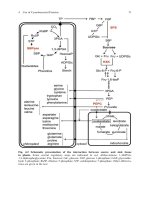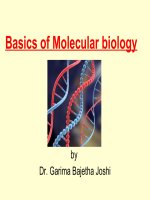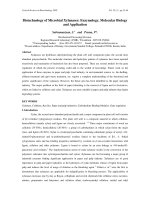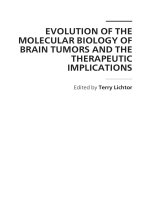- Trang chủ >>
- Đề thi >>
- Đề thi lớp 3
Molecular Biology 5thRobert F WeaverChap 7
Bạn đang xem bản rút gọn của tài liệu. Xem và tải ngay bản đầy đủ của tài liệu tại đây (2.34 MB, 49 trang )
<span class='text_page_counter'>(1)</span>Lecture PowerPoint to accompany. Molecular Biology Fifth Edition. Robert F. Weaver Chapter 7 Operons: Fine Control of Bacterial Transcription Copyright © The McGraw-Hill Companies, Inc. Permission required for reproduction or display..
<span class='text_page_counter'>(2)</span> 7.1 The lac Operon • The lac operon was the first operon discovered • It contains 3 genes coding for E. coli proteins that permit the bacteria to use the sugar lactose – Galactoside permease (lacY) which transports lactose into the cells -galactosidase (lacZ) cuts the lactose into galactose and glucose – Galactoside transacetylase (lacA) whose function is unclear 7-2.
<span class='text_page_counter'>(3)</span> Genes of the lac Operon • The genes are grouped together: – lacZ = -galactosidase – lacY = galactoside permease – lacA = galactoside transacetylase. • All 3 genes are transcribed together producing 1 mRNA, a polycistronic message that starts from a single promoter – Each cistron, or gene, has its own ribosome binding site – Each cistron can be translated by separate ribosomes that bind independently of each other 7-3.
<span class='text_page_counter'>(4)</span> Control of the lac Operon • The lac operon is tightly controlled, using 2 types of control – Negative control, like the brake of a car, must remove the repressor from the operator the “brake” is a protein called the lac repressor – Positive control, like the accelerator pedal of a car, an activator, additional positive factor responds to low glucose by stimulating transcription of the lac operon 7-4.
<span class='text_page_counter'>(5)</span> Negative Control of the lac Operon • Negative control indicates that the operon is turned on unless something intervenes and stops it • The off-regulation is done by the lac repressor – Product of the lacI gene – Tetramer of 4 identical polypeptides – Binds the operator just right of promoter 7-5.
<span class='text_page_counter'>(6)</span> lac Repressor • When the repressor binds to the operator, the operon is repressed – Operator and promoter sequence are contiguous – Repressor bound to operator prevents RNA polymerase from binding to the promoter and transcribing the operon. • As long as no lactose is available, the lac operon is repressed 7-6.
<span class='text_page_counter'>(7)</span> Negative Control of the lac Operon. 7-7.
<span class='text_page_counter'>(8)</span> Inducer of the lac Operon • The repressor is an allosteric protein – Binding of one molecule to the protein changes shape of a remote site on that protein – Altering its interaction with a second molecule. • The inducer binds the repressor – Causing the repressor to change conformation that favors release from the operator. • The inducer is allolactose, an alternative form of lactose 7-8.
<span class='text_page_counter'>(9)</span> Inducer of the lac Operon • The inducer of the lac operon binds the repressor • The inducer is allolactose, an alternative form of lactose. 7-9.
<span class='text_page_counter'>(10)</span> Discovery of the Operon During the 1940s and 1950s, Jacob and Monod studied the metabolism of lactose by E. coli •Three enzyme activities / three genes were induced together by galactosides • Constitutive mutants need no induction, genes are active all the time • Created merodiploids or partial diploid bacteria carrying both wild-type (inducible) and constitutive alleles 7-10.
<span class='text_page_counter'>(11)</span> Discovery of the Operon • Using merodiploids or partial diploid bacteria carrying both wild-type and constitutive alleles distinctions could be made by determining whether the mutation was dominant or recessive • Because the repressor gene produces a repressor protein that can diffuse throughout the nucleus, it can bind to both operators in a meriploid and is called a trans-acting gene because it can act on loci on both DNA molecules • Because an operator controls only the operon on the same DNA molecule it is called a cis-acting gene 7-11.
<span class='text_page_counter'>(12)</span> Effects of Regulatory Mutations: Wild-type and Mutated Repressor. 7-12.
<span class='text_page_counter'>(13)</span> Effects of Regulatory Mutations: Wild-type and Mutated Operator with Defective Binding. 7-13.
<span class='text_page_counter'>(14)</span> Effects of Regulatory Mutations: Wild-type and Mutated Operon binding Irreversibly. 7-14.
<span class='text_page_counter'>(15)</span> Repressor-Operator Interactions • Using a filter-binding assay, the lac repressor binds to the lac operator • A genetically defined constitutive lac operator has lower than normal affinity for the lac repressor • Sites defined by two methods as the operator are in fact the same. 7-15.
<span class='text_page_counter'>(16)</span> The Mechanism of Repression • The repressor does not block access by RNA polymerase to the lac promoter • Polymerase and repressor can bind together to the lac promoter • Polymerase-promoter complex is in equilibrium with free polymerase and promoter. 7-16.
<span class='text_page_counter'>(17)</span> lac Repressor and Dissociation of RNA Polymerase from lac Promoter • Without competitor, dissociated polymerase returns to promoter • Heparin and repressor prevent reassociation of polymerase and promoter • Repressor prevents reassociation by binding to the operator adjacent to the promoter • This blocks access to the promoter by RNA polymerase. 7-17.
<span class='text_page_counter'>(18)</span> Mechanism Summary • Two competing hypotheses of mechanism for repression of the lac operon – RNA polymerase can bind to lac promoter in presence of repressor • Repressor will inhibit transition from abortive transcription to processive transcription. – The repressor, by binding to the operator, blocks access by the polymerase to adjacent promoter 7-18.
<span class='text_page_counter'>(19)</span> lac Operators • There are three lac operators – The major lac operator lies adjacent to promoter – Two auxiliary lac operators - one upstream and the other downstream. • All three operators are required for optimum repression • The major operator produces only a modest amount of repression 7-19.
<span class='text_page_counter'>(20)</span> Catabolite Repression of the lac Operon • When glucose is present, the lac operon is in a relatively inactive state • Selection in favor of glucose attributed to role of a breakdown product, catabolite • Process known as catabolite repression uses a breakdown product to repress the operon. 7-20.
<span class='text_page_counter'>(21)</span> Positive Control of lac Operon • Positive control of the lac operon by a substance sensing lack of glucose that responds by activating the lac promoter – The concentration of a nucleotide, cyclic-AMP (cAMP), rises as the concentration of glucose drops 7-21.
<span class='text_page_counter'>(22)</span> Catabolite Activator Protein • cAMP added to E. coli can overcome catabolite repression of the lac operon • The addition of cAMP leads to the activation of the lac gene even in the presence of glucose • Positive controller of lac operon has 2 parts: – cAMP – A protein factor is known as: • Catabolite activator protein or CAP • Cyclic-AMP receptor protein or CRP • Gene encoding this protein is crp 7-22.
<span class='text_page_counter'>(23)</span> Stimulation of lac Operon CAP-cAMP complex positively controls the activity of -galactosidase – CAP binds cAMP tightly – Mutant CAP not bind cAMP tightly prepared – Compare activity and production of galactosidase using both complexes – Low activity with mutant CAP-cAMP 7-23.
<span class='text_page_counter'>(24)</span> The Mechanism of CAP Action • The CAP-cAMP complex binds to the lac promoter – Mutants whose lac gene is not stimulated by complex had the mutation in the lac promoter – Mapping the DNA has shown that the activator-binding site lies just upstream of the promoter. • Binding of CAP and cAMP to the activator site helps RNA polymerase form an open promoter complex 7-24.
<span class='text_page_counter'>(25)</span> CAP plus cAMP allow formation of an open promoter complex • The open promoter complex does not form, even if RNA polymerase has bound the DNA, unless the CAP-cAMP complex is also bound. 7-25.
<span class='text_page_counter'>(26)</span> CAP • Binding sites for CAP in lac, gal and ara operons all contain the sequence TGTGA – Sequence conservation suggests an important role in CAP binding – Binding of CAP-cAMP complex to DNA is tight. • CAP-cAMP activated operons have very weak promoters – Their -35 boxes are quite unlike the consensus sequence – If these promoters were strong they could be activated even when glucose is present 7-26.
<span class='text_page_counter'>(27)</span> Recruitment • CAP-cAMP recruits polymerase to the promoter in two steps: – Formation of the closed promoter complex – Conversion of the closed promoter complex into the open promoter complex. R P RPc k2 RPo KB • CAP-cAMP bends its target DNA by about 100° when it binds 7-27.
<span class='text_page_counter'>(28)</span> CAP-cAMP Promoter Complexes. 7-28.
<span class='text_page_counter'>(29)</span> Proposed CAP-cAMP Activation of lac Transcription • The CAP-cAMP dimer binds to its target site on the DNA • The CTD (-carboxy terminal domain) of polymerase interacts with a specific site on CAP • Binding is strengthened between promoter and polymerase 7-29.
<span class='text_page_counter'>(30)</span> Summary • CAP-cAMP binding to the lac activatorbinding site recruits RNA polymerase to the adjacent lac promoter to form a closed complex • CAP-cAMP causes recruitment through protein-protein interaction with the CTD of RNA polymerase. 7-30.
<span class='text_page_counter'>(31)</span> 7.2 The ara Operon • The ara operon of E. coli codes for enzymes required to metabolize the sugar arabinose • It is another catabolite-repressible operon. 7-31.
<span class='text_page_counter'>(32)</span> Features of the ara Operon • Two ara operators exist: – araO1 regulates transcription of a control gene called araC – araO2 is located far upstream of the promoter it controls (PBAD). • The CAP-binding site is 200 bp upstream of the ara promoter, yet CAP stimulates transcription • This operon has another system of negative regulation mediated by the AraC protein 7-32.
<span class='text_page_counter'>(33)</span> The ara Operon Repression Loop • The araO2 operator controls transcription from a promoter 250 downstream • Does the DNA between the operator and the promoter loop out?. 7-33.
<span class='text_page_counter'>(34)</span> The ara Control Protein • The AraC, ara control protein, acts as both a positive and negative regulator • There are 3 binding sites • Far upstream site, araO2 • araO1 located between -106 and -144 • araI is really 2 half-sites – araI1 between -56 and -78 – araI2 -35 to -51 – Each half-site can bind one monomer of AraC 7-34.
<span class='text_page_counter'>(35)</span> The araCBAD Operon The ara operon is also called the araCBAD operon for its 4 genes – Three genes, araB, A, and D, encode the arabinose metabolizing enzymes – These are transcribed rightward from the promoter araPBAD – Other gene, araC • Encodes the control protein AraC • Transcribed leftward from the araPc promoter 7-35.
<span class='text_page_counter'>(36)</span> AraC Control of the ara Operon • In absence of arabinose, no araBAD products are needed, AraC exerts negative control – Binds to araO2 and araI1 – Loops out the DNA in between – Represses the operon. • Presence of arabinose, AraC changes conformation – – – –. It can no longer bind to araO2 Occupies araI1 and araI2 instead Repression loop broken Operon is derepressed 7-36.
<span class='text_page_counter'>(37)</span> Control of the ara Operon. 7-37.
<span class='text_page_counter'>(38)</span> Positive Control of the ara Operon • Positive control is also mediated by CAP and cAMP • The CAP-cAMP complex attaches to its binding site upstream of the araBAD promoter • DNA looping would allow CAP to contact the polymerase and thereby stimulate its binding to the promoter 7-38.
<span class='text_page_counter'>(39)</span> ara Operon Summary • The ara operon is controlled by the AraC protein – Represses by looping out the DNA between 2 sites, araO2 and araI1 that are 210 bp apart. • Arabinose can derepress the operon causing AraC to loosen its attachment to araO2 and bind to araI2 – This breaks the loop and allows transcription of operon. • CAP and cAMP stimulate transcription by binding to a site upstream of araI – AraC controls its own synthesis by binding to araO1 and prevents leftward transcription of the araC gene 7-39.
<span class='text_page_counter'>(40)</span> 7.3 The trp Operon • The E. coli trp operon contains the genes for the enzymes the bacterium needs to make the amino acid tryptophan • The trp operon codes for anabolic enzymes, those that build up a substance • Anabolic enzymes are typically turned off by a high level of the substance produced • This operon is subject to negative control by a repressor when tryptophan levels are elevated • trp operon also exhibits attenuation 7-40.
<span class='text_page_counter'>(41)</span> Tryptophan’s Role in Negative Control of the trp Operon • Five genes code for the polypeptides in the enzymes of tryptophan synthesis • The trp operator lies wholly within the trp promoter • High tryptophan concentration is the signal to turn off the operon • The presence of tryptophan helps the trp repressor bind to its operator 7-41.
<span class='text_page_counter'>(42)</span> Negative Control of the trp Operon • Without tryptophan no trp repressor exists, just the inactive protein, aporepressor • If aporepressor binds tryptophan, changes conformation with high affinity for trp operator • Combine aporepressor and tryptophan to form the trp repressor • Tryptophan is a corepressor. 7-42.
<span class='text_page_counter'>(43)</span> Attenuation in the trp Operon. 7-43.
<span class='text_page_counter'>(44)</span> Mechanism of Attenuation • Attenuation imposes an extra level of control on an operon • Operates by causing premature termination of the operon’s transcript when product is abundant • In the presence of low tryptophan concentration, the RNA polymerase reads through the attenuator so the structural genes are transcribed • In the presence of high tryptophan concentration, the attenuator causes premature termination of transcription 7-44.
<span class='text_page_counter'>(45)</span> Defeating Attenuation • Attenuation operates in the E. coli trp operon as long as tryptophan is plentiful • If amino acid supply low, ribosomes stall at the tandem tryptophan codons in the trp leader • trp leader being synthesized as stalling occurs, stalled ribosome will influence the way RNA folds – Prevents formation of a hairpin – This is part of the transcription termination signal which causes attenuation 7-45.
<span class='text_page_counter'>(46)</span> Overriding Attenuation. 7-46.
<span class='text_page_counter'>(47)</span> 7.4 Riboswitches • Small molecules can act directly on the 5’UTRs of mRNAs to control their expression • Regions of 5’-UTRs capable of altering their structures to control gene expression in response to ligand binding are called riboswitches. 7-47.
<span class='text_page_counter'>(48)</span> Riboswitch Action • Region that binds to the ligand is an aptamer • An expression platform is another module in the riboswitch which can be: – Terminator – Ribosome-binding site – Another RNA element that affects gene expression. • Operates by depressing gene expression – Some work at the transcriptional level – Others can function at the translational level 7-48.
<span class='text_page_counter'>(49)</span> Model of Riboswitch Action • FMN binds to aptamer in a riboswitch called the RFN element in 5’-UTR of the ribD mRNA • Binding FMN, base pairing in riboswitch changes to create a terminator • Transcription is attenuated • Saves cell energy as FMN is a product of the ribD operon. 7-49.
<span class='text_page_counter'>(50)</span>









